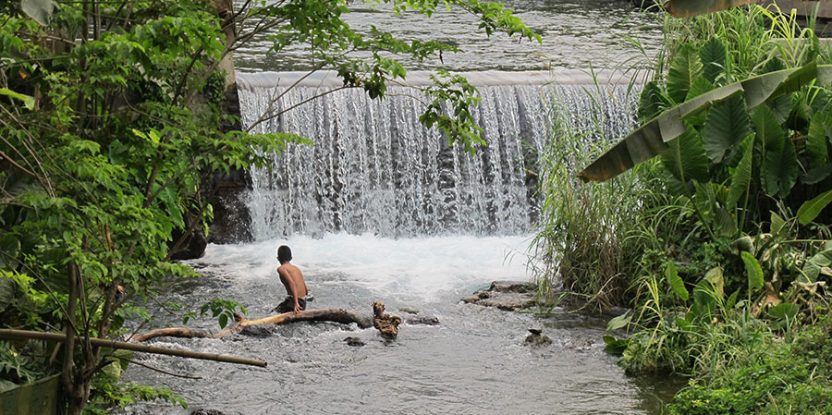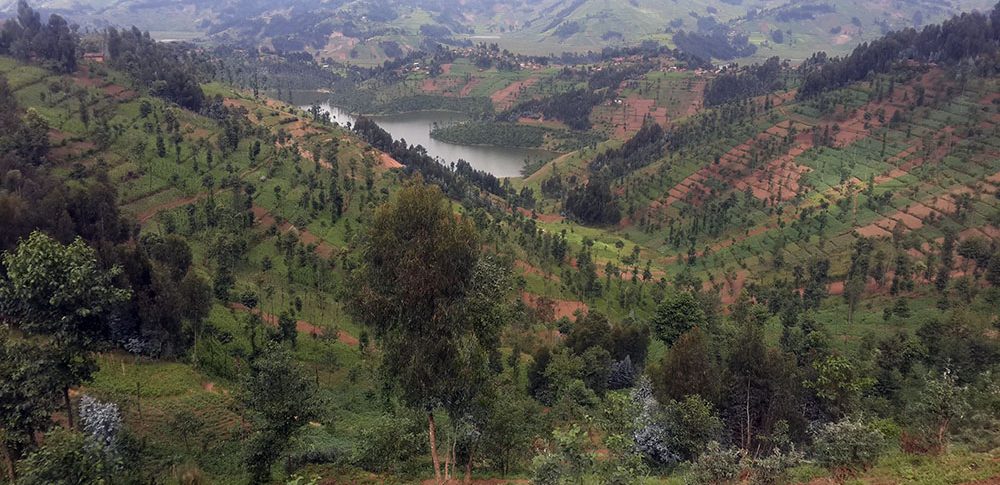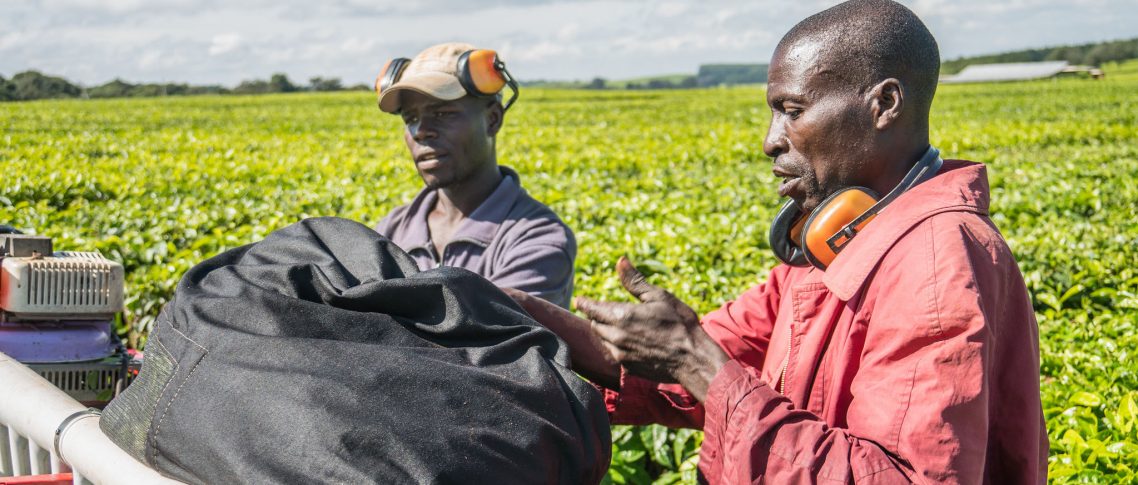
Water makes headlines every day. Many of the world’s rivers are drying up, and we’re getting used to seeing images of landscapes transformed by drought-fed wildfires or once-a-century flooding.
Meanwhile, the number of people experiencing hunger and malnutrition has grown to over 828 million – up 150 million since the outbreak of the COVID-19 pandemic. Many are facing an ever steeper struggle to feed their families from land that is either dried out and depleted, or submerged under heavy rain or the encroaching sea.
At highest risk are those who depend on rainfall to produce food. In Africa, over 95 percent of food production is rainfed, while only 5 percent of public agricultural water investments support rainfed agriculture.
But the solution may be right above our heads.
“Most countries in sub-Saharan Africa currently use only 5 percent of their rainwater potential,” says Maimbo Malesu, who heads the Water Management Unit at CIFOR-ICRAF (the Center for International Forestry Research and World Agroforestry) and its Zambia office. “Incorporating green water could improve both food security and ecosystem health.”
Water colours
In the tropics, water comes mainly from two sources: ‘flying rivers’, or streams of atmospheric moisture (‘rainbow water’) that bring cloud cover and rainfall, and ‘water towers’ – higher elevation watersheds that generate rivers (‘blue water’) which descend to drier downstream areas. Rivers collect about a third of the total rainfall over land.
Trees and other plants use the other two-thirds as ‘green water’ through evapotranspiration. Changes in land cover between forest, grassland, and open-field crops affect the capacity of soils to absorb water, as well as the ability of vegetation to use it and recycle it into the atmosphere. For instance, deep-rooted trees draw water up from deep soil layers, and leak some of it into topsoil, where crops can use it. “Water essentially goes to waste in the absence of trees, which help prevent soil erosion,” said Malesu. “‘Trees within a farming system – as in agroforestry – manage water better, increase productivity, and enhance the value of water. But this green water is ignored in hydrological planning.”
CIFOR-ICRAF scientist Aster Gebrekirstos Afwork echoed Malesu’s comments. “The role of trees in modifying micro- and meso-climates and in the hydrological cycle is completely ignored in the global climate change discourse,” she said. The Abraha We Atsbeha community in Tigray, with whom she has conducted research, “describe the ecosystem benefits of landscape restoration as a ‘water bank’, in which time and labour invested in restoring degraded lands upstream recharges the groundwater that supplies the ‘ATM machine’ downstream,” she said. “This was because the number of shallow wells increased significantly as a result of the rising water table and landscape-level infiltration during the rainy season. As a result, farmers could easily develop hand-dug wells and check dams for growing vegetables and fruit trees through small-scale irrigation practices, which enabled them to cultivate twice during the off-season.”
Tapping into green water could be a game changer. “At an estimated USD250-500 per hectare, investing in green water management in rainfed smallholder farming is a cost-effective and sustainable way to increase productivity, with added benefits,” said Catherine Muthuri, who is CIFOR-ICRAF Country Director for Kenya, Regional Convener for East Africa, and co-lead of the Transformative Partnership Platform on optimizing rainwater in rainfed agriculture.
The Transforming Investments in African Rainfed Agriculture (TIARA) initiative, which is led by the Stockholm International Water Institute (SIWI), the Global Green Growth Institute (GGGI), and CIFOR-ICRAF, aims to help improve food and water security and build climate resilience among rural communities by drawing attention to – and investment in – enhanced rainfed agriculture in Africa. TIARA will be the focus of a CIFOR-ICRAF session at the World Water Week event held virtually and in Stockholm, Sweden from 23 August to 1 September.
TIARA has scoped out the potential of green water in the Zambezi basin with a range of stakeholder consultations and dialogues, and provided analysis of key issues and barriers. The experiences and lessons learned will inform the development of an Africa-wide TIARA programme that’s tailored to fit local circumstances. The programme will deliver national and regional partnerships with governments, river basin organisations, and regional economic communities, to create an enabling environment for enhanced rainfed agriculture in Africa.

Front line workers
Smallholders who practise rainfed agriculture are on the front line of water management. They usually have little or no support or training in how to sustainably use scarce water resources. But they manage to boost yields by capturing rainwater and keeping it within the root zone of their crops, along with other simple approaches to increase soil moisture and green water, and reduce water and soil nutrient losses.
Enhanced rainfed agriculture is an umbrella term incorporating a range of approaches that align with regenerative agriculture, rainwater harvesting and conservation agriculture. “At the heart of enhanced rainfed agriculture is the need to increase the availability and improve the management of green water,” said Muthuri. “Many of its approaches are built on traditional practices/knowledge and can be implemented at low cost. This, coupled with matching tree species and management options to appropriate contexts, results in efficient use of water where every drop counts, leading to improved yields, economic growth and job creation, gender equality, enhanced livelihoods, social benefits and improved climate resilience.”
To harvest rainwater, farmers can build zaï pits (small planting basins) and ‘half-moon’ trenches, or create stone and earth bunds or grass strips that redirect runoff towards crops – an approach called contour farming. They can also minimize soil tillage, and use cover crops and mulch to limit the amount of soil and water lost through evaporation, rain splash erosion, and runoff. Other approaches include water harvesting and conservation in farm ponds, sand dams, and tanks to provide a source of irrigation during dry periods. Groundwater can be recharged using trenches and percolation pits, and organic manure can be used to improve soil fertility and structure.
Investing in enhanced rainfed agriculture and green water isn’t meant to replace irrigation or other solutions: the main goal is to provide basic water security. “A first step in building sustainable livelihoods is ensuring that, at the very least, farmers do not fall below the subsistence point,” said Muthuri. “Securing green water should be seen as part of a broader, integrated approach to water management.”
On the ground
In Kenya, 80 percent of land is classified as arid or semi-arid – much of which is being rapidly degraded. In that context, CIFOR-ICRAF’s Kenya Rangelands Ecosystem Services Productivity Programme aims to improve livelihoods and landscapes by enhancing the productivity of ecosystem services provided by rangelands for food, feed, and human and wildlife security in the Amaya Triangle counties of Laikipia, Samburu, Isiolo, and Baringo. In addition to promoting tree-based enterprises and investment, establishing community tree nurseries, and identifying ways to use agroforestry for climate mitigation and adaptation, the project includes a component on the design and installation of rain- and floodwater harvesting systems to support tree growth and improve pasture on croplands and rangelands. “Kenya’s rainwater potential is more than 350 billion cubic meters,” said Malesu. “If captured and managed, the water is enough to support 233 million people or close to four times the country’s population in 2022.”
Safe access to water is so critical in Kenya that it was identified as a top-5 indicator for land restoration monitoring through engagement across the country’s 47 counties, as part of a UK-funded CIFOR-ICRAF project on nature-based solutions for restoration.
A recent assessment of land and water resources in five selected rainfed hotspots in Zambia, Zimbabwe, Malawi, and Mozambique revealed that almost all of the sites have a rainfed suitability period of 1–3 months – except the Lake Malawi cross-border area with Tanzania, which has a suitability period of 4–6 months. However, the run-off harvesting potential is very low (except for in Lake Malawi). The risk of soil erosion is also greatest on cropland. So, to enhance rainfed agriculture, there is a need to closely monitor the onset and offset of rain, increase in-situ water harvesting techniques, and promote conservation agriculture in general.
Hope springs
In the Rejoso catchment in East Java, Indonesia, a team of researchers has been working for many years to identify ways to improve the capacity of the watershed to increase water infiltration and regulate water intake for agriculture use. This integrated watershed and water resource management aims to return water flows to springs that supply Surabaya, Indonesia’s second-largest city.
The first phase of the Gerakan Rejoso Kita (‘our Rejoso platform’) initiative provided proof-of-concept that restoring and maintaining watershed functions is achievable by creating co-invested, performance-based schemes that incentivize upstream and midstream smallholders to practise agroforestry and conservation agriculture. Ninety-four farmers covering 44.3 hectares of paddy have practiced individual sustainable paddy cultivation. By introducing tanam serempak (collective planting with a harmonized planting calendar in a block), the programme engaged 184 farmers across 65.1 ha.
“Our data show that sustainable paddy cultivation can produce 32% more grain, and use water 15% more efficiently than conventional practices,” said Ni’matul Khasanah, an ecological modeller at CIFOR-ICRAF Indonesia. “This meant a 123% higher net profit for farmers, and a 36% lower greenhouse gas emission. To get this true win-win-win opportunity realized, however, requires improved well-drilling techniques that allow for better control of water use, and changes in rules for legal permits for drilling – a real challenge for policy integration.”
The initiative also explored innovative finance mechanisms, encouraging farming communities to organize themselves to obtain capital, and worked with multi-stakeholder platforms and forums at various jurisdictions for better watershed management. Within six years of the action research programme, the pilots by Rejoso Kita in the up-, mid-, and downstream parts of the watershed used a landscape approach for designing payments for ecosystem services (PES).
“The PES pilot in Rejoso involved 174 farmers in seven villages covering 106.6 hectares who got a performance-based contractual agreement with the national bottled-water company Danone,” said Beria Leimona, Senior Expert in Landscape Governance at CIFOR-ICRAF. “When replicated, the PES schemes can increase infiltration by 0.5–1% and reduce surface runoff by 1.5–2% of annual rainfall by maintaining 300–500 trees per hectare; these effects are modest in recharging groundwater, but complement more efficient groundwater use downstream.”
Seeing the water for the trees
Most of the estimated four billion people who lack sufficient access to clean water live in areas with low forest cover. Trees draw water from underground and slowly release it through their leaves; they also ‘catch’ heavy rainfall and slow runoff; stabilize river banks; and create microclimates for crops and biodiversity.
“Forests and trees have been associated with rainfall since at least the classical Greek era, but only recently have mechanisms been clarified,” said Meine van Noordwijk, a Distinguished Science Fellow with CIFOR-ICRAF, who co-authored a recent paper that challenged the commonly used ‘water footprint’ metric and suggested alternatives that take rainfall recycling into account. “Beyond the blue-versus-green water competition that cautions against planting dense stands of fast-growing trees in dry areas, the full spectrum of colours – blue, green, grey and rainbow – needs to be understood in managing water in view of all Sustainable Development Goals.”
Simply put, growing the right trees in the right places remains the most effective way to draw maximum value from rainwater.
We want you to share Forests News content, which is licensed under Creative Commons Attribution-NonCommercial-ShareAlike 4.0 International (CC BY-NC-SA 4.0). This means you are free to redistribute our material for non-commercial purposes. All we ask is that you give Forests News appropriate credit and link to the original Forests News content, indicate if changes were made, and distribute your contributions under the same Creative Commons license. You must notify Forests News if you repost, reprint or reuse our materials by contacting forestsnews@cifor-icraf.org.
